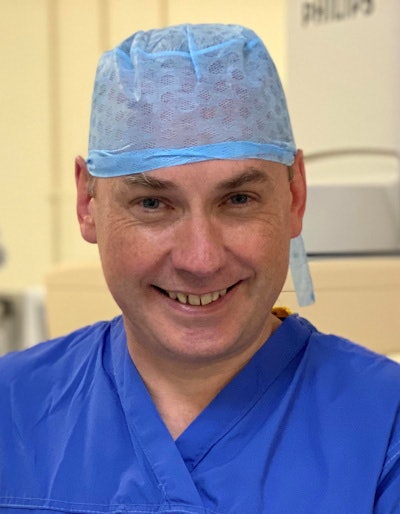
I go to obtain informed consent from a man for an angioplasty. He had a full-length stenting of his superficial femoral artery 12 months ago. This was a difficult procedure, and it required several attempts over a few days and multiple punctures into the artery at the groin, behind the knee, and at the ankle.
 Dr. Chris Hammond from Leeds, U.K.
Dr. Chris Hammond from Leeds, U.K.The procedure was done to treat an ulcer, and this has slowly improved, but it is still not fully healed. The patient tells me that his prior procedures were dreadful: painful, long, and frightening. He is clearly anxious about undergoing another one, and yet he is ready to go through it all again.
The patient is here because a surveillance ultrasound has shown a stenosis in the stents. The protocol kicked in, an angioplasty was booked, preassessment happened, and arrangements were made. We go through the consent process together. He signs the form, we wheel him into the angio suite, and off we go.
Thinking about my patient's interaction with this small part of his healthcare, what strikes me is the degree to which the process disenfranchises him: his role seems passive in the face of an inevitable and gathering momentum that brings him into surveillance and from there to the angiography suite.
Apart from the uncertainties involved (Does he need an angioplasty at all? What happens if nothing is done?), it is unclear what opportunity there has been to explore his hopes and expectations for this treatment. Why have we called him here? What does he want? What do we want? Are those the same things? Even the language used ("consenting") creates a sense of passivity. It implies something is being done to the patient, not done with them.
Growing complexity
Healthcare decision-making is becoming increasingly complicated due to an ageing and comorbid population, the management of imaging findings with an unknown natural history, and a wealth of competing technological treatment options with differing profiles of risk and benefit over time and for different patient cohorts. On top of this are the substantial uncertainties in the evidence about each of these.
Confronted with these changes, it seems essential that patients are given the space to consider their options and -- perhaps more importantly -- to reflect on their broader preferences and how they might weigh their treatment options in the context of these. Taking patients through this is delicate, time-consuming, and sometimes uncomfortable for everyone, especially if discussions broach the nature of risk or the inevitability of a finite lifespan.
The U.K. General Medical Council's guidance on consent highlights information sharing, but it also emphasizes the importance of a dialogue and (crucially) on finding out what matters to patients, their "wishes and fears ... and their needs, values, and priorities." The 2015 Montgomery Ruling has created legal precedent effectively requiring such a dialogue. Clinicians are notoriously poor at doing this and patient surveys often identify information gaps, misunderstandings, and assumptions -- by both patients and clinicians -- about motivations and drivers for care. In retrospect, patients not infrequently regret their decisions.
Additionally, as treatment complexity increases, an individual's healthcare becomes distributed across teams of specialist technicians, each with their own narrow area of expertise. Treatment pathways become 'protocolized' and a patient's relationship changes from being with an individual to being with an organization.
When a patient sees different professionals at every stage of their healthcare journey, there is little opportunity for the development of the rapport and trust that gives them freedom to state their preferences and question the assumptions driving their management. Every individual interaction adds to the momentum toward a predetermined outcome that they might not want. Paradoxically, as the decision-making complexity increases, the opportunity for dialogue exploring the decision-making declines.
What might we do differently?
Decision-support tools are being investigated to help patients navigate the complexities of high-risk surgical decision-making. In the meantime, I am struck by a personal analogy about a complicated decision I recently had to make. Many of the conceptual issues when making an investment decision are similar to those made by patients about healthcare: the trade-off of short- and long-term outcomes, the nature and magnitude of uncertainty in these, and the reliance on an expert to interpret complicated data and communicate them in a meaningful way and the willingness to delegate some of the decision-making.
But what was very different in my decision-making was what my financial advisor and I did before we began to talk about particular investments. We spent a long time assessing my attitude toward risk, my view on ethical or green investments, the time frame over which the investment was required, and the context of the investment within my other priorities. Only then did we move on to discuss potential investment vehicles.
I ended up agreeing to the advisor's recommendation. I'm not sure I fully understand the complete details. I certainly couldn't quote the numbers. But I am sure I trust my advisor's recommendation, knowing that he knows what my perspectives are.
There are similar (though limited) models in healthcare. The U.K. Resuscitation Council's Recommended Summary Plan for Emergency Care and Treatment (ReSPECT) and the U.S. Physician Orders for Life Sustaining Treatments (POLST) processes encourage patients and clinicians to discuss personal priorities for care and options for management in the event of an emergency toward the end of life (frequently, though not exclusively, meaning cardiopulmonary resuscitation [CPR]) in the event of cardiac arrest or other ceilings of care such as transfer to the intensive therapy unit.
Having these conversations is difficult, but their importance lies not only in the outcome but also in the process itself that explicitly demonstrates patients retain agency and that healthcare organizations recognize and value this.
Can we adopt similar models more broadly in consent? Perhaps. We need to develop practical techniques and questions which allow wider perspectives to be explored with patients. However, the fundamental prerequisite is that we are curious about what our patients want and on their terms, not on ours. We need to offer them time, space, and support to help them express these wants, and we need to listen, understand, and heed them before we negotiate a decision.
A focus on consent as a technical exercise in the sharing of information is a narrow and meager understanding. Ideally, consent is an exploration of the patient's values and priorities, and then a contextualizing of the treatment choices on offer in the light of these priorities. Unfortunately, this is often logistically impossible.
My patient's angioplasty was quick, technically successful, and apparently pain-free. I booked him back into surveillance. Is this what he wanted? I don't know. I'm sorry to say, I didn't ask.
Dr. Chris Hammond is a consultant vascular radiologist and clinical lead for interventional radiology at Leeds Teaching Hospitals NHS Trust, Leeds, U.K.
The comments and observations expressed herein do not necessarily reflect the opinions of AuntMinnieEurope.com, nor should they be construed as an endorsement or admonishment of any particular vendor, analyst, industry consultant, or consulting group.




















